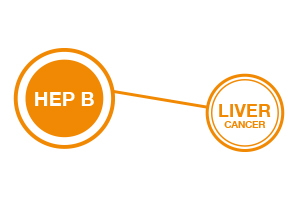You may be at increased risk for hepatitis B if you
Have sex with someone who is infected
Have multiple sexual partners
Have a sexually transmitted disease
Are a man who has sex with other men
Inject drugs
Live with someone who has chronic hepatitis B
Have traveled to a country where many people have hepatitis B
Get long-term hemodialysis
Regardless of your risk factors for Hepatitis B infection, Think About The Link recommends:
Vaccination against the hepatitis B virus
Screening for those vulnerable to hepatitis B infection
Treatment for those living with hepatitis B to reduce the risk of liver cancer
Hepatitis B and Cancer
Liver cancer is the 2nd leading cause of cancer death worldwide, while hepatitis B is the #1 cause of it.
Hepatitis B and Liver Cancer in the U.S.
Each year in the U.S., about 20,000 men and 8,000 women are diagnosed with liver cancer, and about 16,000 men and 7,000 women die from the disease.
Hispanic men and women are twice as likely to have, and to die from, liver cancer.
Hispanic men are more likely to have hepatitis B than Hispanic women.
Hepatitis B diagnosis and therapy can reduce liver cancer risk by 50-80 percent.
The Virus
Hepatitis B is a liver infection caused by the hepatitis B virus. An individual can become infected with hepatitis B through transmission of bodily fluids from an infected person. Transmission can occur through sexual contact; sharing needles, syringes, or other recreational drug-injection equipment; or from mother-to-child during birth.
The Cancer Link
Hepatitis B is a silent infection that shows signs and symptoms at varying ages. Most infected children and adults with weakened immune systems show no symptoms; but 30 percent to 50 percent of people ages five years and older do show symptoms, including (but not limited to) fever, fatigue, loss of appetite and nausea. Infants and small children who become infected have a 90 percent chance of becoming chronic carriers. When hepatitis B is left untreated, up to 25 percent of people chronically infected develop cirrhosis (liver decay) or liver cancer.
The Hepatitis B Vaccine is Cancer Prevention
A safe and effective vaccine is currently approved to protect against hepatitis B. The best way to prevent hepatitis B is to get vaccinated. The Centers for Disease Control and Prevention recommends all children receive their first dose of hepatitis B vaccine at birth and complete the three- to four-dose series between six to 18 months of age. Children up to 18 years old should also receive the vaccine if they did not receive it earlier. Talk to your health care provider about getting yourself and your children vaccinated to prevent liver cancer and other health issues. People who travel to certain countries where the virus is prevalent also should consider getting the vaccine.
Think About the Link® recommends

Vaccination against the hepatitis B virus.

Screening for those vulnerable to hepatitis B infection.

Treatment for those living with hepatitis B to reduce the risk of liver cancer.
Did You Know?
Approximately 700,000 to 1.4 million people in the U.S. have a chronic hepatitis B virus infection.
Chronic hepatitis B infections cause up to 60% of all liver cancers worldwide.
Less than one in seven Hispanic adults are aware Hispanic adults have higher rates of hepatitis B-related liver cancers.
There are as many as 2.2 million Americans living with hepatitis B and most don’t know it.